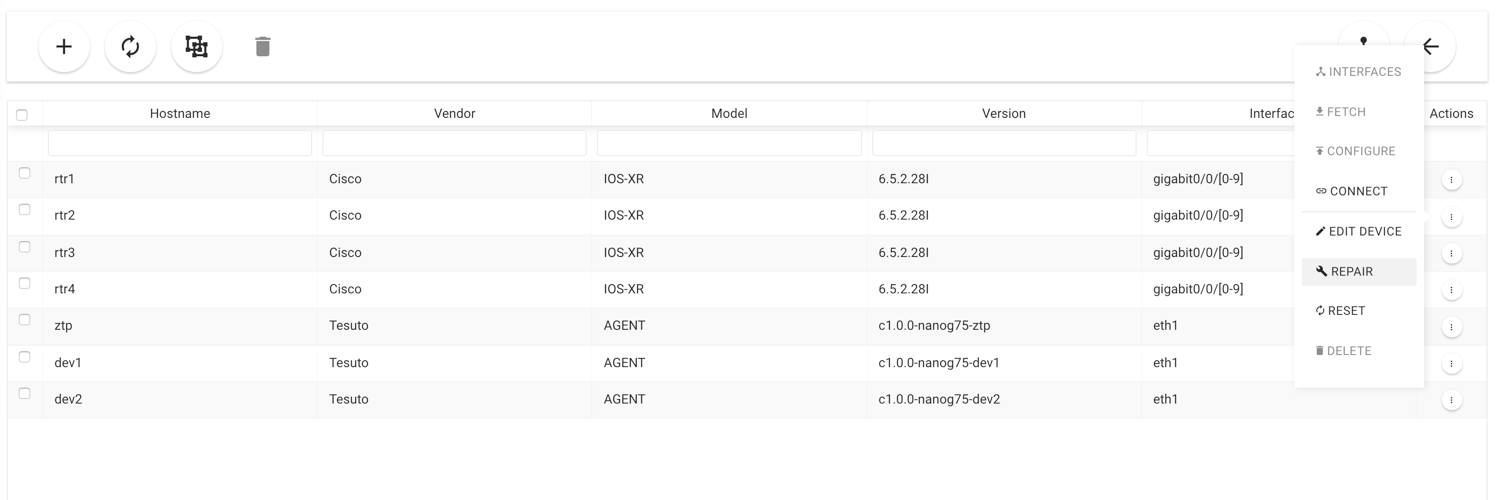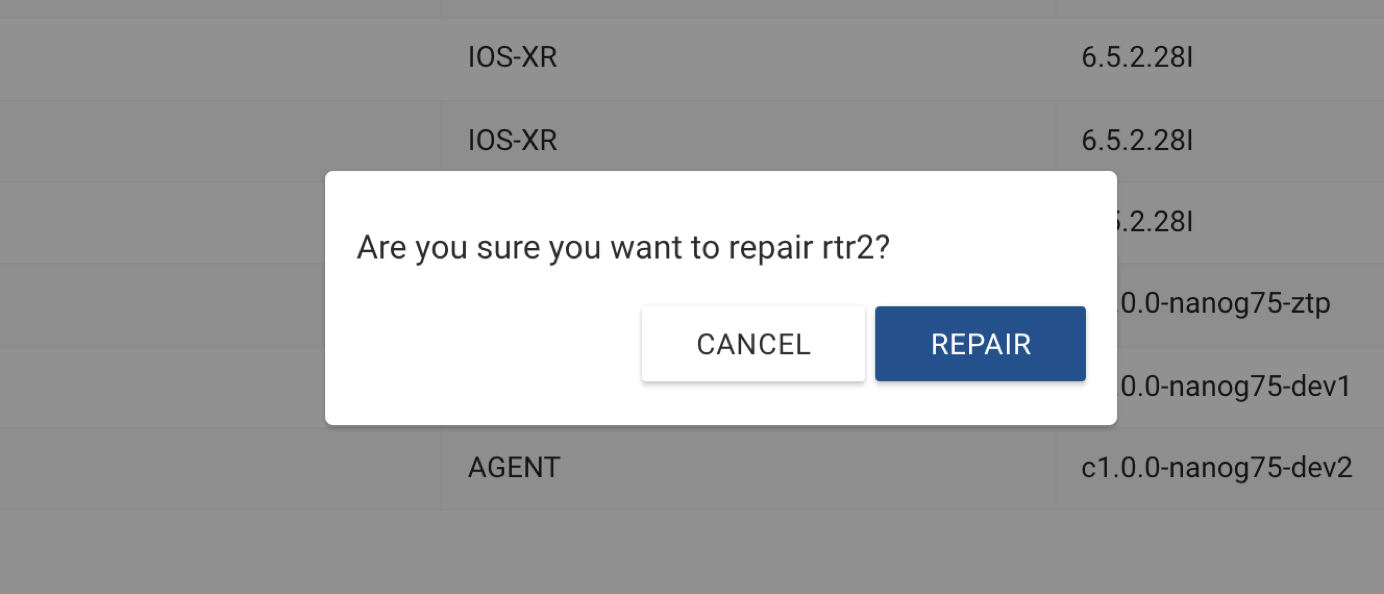Step 2: Performing ZTP
Console into your router
To do this, first ssh to the Base Pod VM (assuming podx):
AKSHSHAR-M-33WP:~ akshshar$ ssh -i ~/nanog75.key tesuto@hackathon.podx.cloud.tesuto.com
Last login: Sun Feb 17 03:04:40 2019 from 172.17.0.1
== Tesuto Jumpbox ==
Type '?' or 'help' to get the list of commands
Running Hosts:
host: rtr1
ip: 100.96.0.14
host: rtr2
ip: 100.96.0.16
host: rtr3
ip: 100.96.0.18
host: ztp
ip: 100.96.0.20
host: dev1
ip: 100.96.0.22
host: dev2
ip: 100.96.0.24
host: rtr4
ip: 100.96.0.26
tesuto@jumpbox:~$
tesuto@jumpbox:~$
As the above output indicates, on the Base pod VM you can press ? to see the list of commands available to you.
To console into router rtr2, simply type: console rtr2 on the base Pod VM:
For your convenience, we have set up a backdoor user on the router with credentials:
Username: rtrdev Password: nanog75sf
On an actual router, this user is not present, this is only been made available for this hackathon to make things simpler.
tesuto@jumpbox:~$ console rtr2
Trying 10.138.0.20...
Connected to rtr2-console.
Escape character is '^]'.
rtr
User Access Verification
Username: rtrdev
Password:
RP/0/RP0/CPU0:ios#
RP/0/RP0/CPU0:ios#
RP/0/RP0/CPU0:ios#
RP/0/RP0/CPU0:ios#
RP/0/RP0/CPU0:ios#
Testing your ZTP script
You don’t need to actually perform ZTP to test your ZTP script. To accomplish this, first ssh into your ZTP box:
AKSHSHAR-M-33WP:~ akshshar$ ssh -i ~/nanog75.key tesuto@ztp.hackathon.pod0.cloud.tesuto.com
Warning: the ECDSA host key for 'ztp.hackathon.pod0.cloud.tesuto.com' differs from the key for the IP address '35.197.94.94'
Offending key for IP in /Users/akshshar/.ssh/known_hosts:1
Matching host key in /Users/akshshar/.ssh/known_hosts:5
Are you sure you want to continue connecting (yes/no)? yes
Welcome to Ubuntu 18.04.1 LTS (GNU/Linux 4.15.0-45-generic x86_64)
* Documentation: https://help.ubuntu.com
* Management: https://landscape.canonical.com
* Support: https://ubuntu.com/advantage
System information as of Sun Feb 17 09:38:59 UTC 2019
System load: 0.0 Processes: 110
Usage of /: 9.6% of 21.35GB Users logged in: 0
Memory usage: 2% IP address for ens3: 100.96.0.20
Swap usage: 0%
* 'snap info' now shows the freshness of each channel.
Try 'snap info microk8s' for all the latest goodness.
Get cloud support with Ubuntu Advantage Cloud Guest:
http://www.ubuntu.com/business/services/cloud
* Canonical Livepatch is available for installation.
- Reduce system reboots and improve kernel security. Activate at:
https://ubuntu.com/livepatch
8 packages can be updated.
0 updates are security updates.
Last login: Sun Feb 17 07:51:28 2019 from 128.107.241.176
tesuto@ztp:~$
tesuto@ztp:~$
tesuto@ztp:~$
tesuto@ztp:~$
Start editing the script in the location: /var/www/html/scripts/ztp_ncclient.py (you will need to become sudo).
tesuto@ztp:~$ sudo vi /var/www/html/scripts/ztp_ncclient.py
Once changed, then console into the router as explained earlier above and drop into the router bash shell:
RP/0/RP0/CPU0:ios#
RP/0/RP0/CPU0:ios#
RP/0/RP0/CPU0:ios#bash
Sun Feb 17 09:42:58.139 UTC
[host:~]$
[host:~]$
Now download the ZTP script you just edited/modified into the router bash, make it executable and run it:
[host:~]$ wget http://100.96.0.20/scripts/ztp_ncclient.py
--2019-02-17 09:43:19-- http://100.96.0.20/scripts/ztp_ncclient.py
Connecting to 100.96.0.20:80... connected.
HTTP request sent, awaiting response... 200 OK
Length: 10733 (10K) [text/x-python]
Saving to: 'ztp_ncclient.py'
100%[======================================>] 10,733 --.-K/s in 0s
2019-02-17 09:43:19 (217 MB/s) - 'ztp_ncclient.py' saved [10733/10733]
[host:~]$
[host:~]$
[host:~]$ chmod +x ztp_ncclient.py
[host:~]$
[host:~]$
[host:~]$ ./ztp_ncclient.py
This becomes a quick way to test your ZTP script and the router bash shell allows you to use all typical python interpreter capabilities to ease the process.
Testing the ZTP process
Ok, so you’ve created a ZTP script that works, now what?
Well, time to test the ZTP workflow:
We have already seen that the DHCP server is set up to respond with the location of the script ztp_ncclient.py to router rtr2 when it sends the appropriate ZTP request.
There are two ways to perform ZTP on any router in the current topology:
Manually from console while the router is up
To initiate ZTP on router rtr2 while it is still up, first connect to the console of router rtr2.
Now to initiate ZTP manually, we basically need to execute the CLI ztp initiate noprompt in the router CLI shell. However, since this setup reserves a single IP address from the DHCP server for each router, executing ZTP manually from an already provisioned box (rtr2) will fail since the ISC-DHCP server will not reissue an IP to the router that already has the IP present.
To make it simple, we have a created a small script to remove the ip from the Managment port and execute ztp initiate noprompt for us.
So, in order to perform manual ZTP on any of the routers in the topology, simply run the following commands in router console:
RP/0/RP0/CPU0:ios#
RP/0/RP0/CPU0:ios#bash
Sun Feb 17 09:18:46.493 UTC
[host:~]$
[host:~]$
[host:~]$ wget http://100.96.0.20/scripts/retry_manual_ztp.sh
--2019-02-17 09:19:04-- http://100.96.0.20/scripts/retry_manual_ztp.sh
Connecting to 100.96.0.20:80... connected.
HTTP request sent, awaiting response... 200 OK
Length: 881 [text/x-sh]
Saving to: 'retry_manual_ztp.sh.1'
100%[======================================>] 881 --.-K/s in 0s
2019-02-17 09:19:04 (79.2 MB/s) - 'retry_manual_ztp.sh.1' saved [881/881]
[host:~]$
[host:~]$ chmod +x retry_manual_ztp.sh
[host:~]$
[host:~]$ ./retry_manual_ztp.sh
+ read -r -d '' mgmt_clean_config
+ xrapply_string '!
interface MgmtEth0/RP0/CPU0/0
no ipv4 address
shutdown
!
!
end'
+ xrnns_apply_string '!
interface MgmtEth0/RP0/CPU0/0
no ipv4 address
shutdown
!
!
end'
++ mktemp
+ local filename=/tmp/tmp.3PLe1NGYaN
+ printf '!
interface MgmtEth0/RP0/CPU0/0
no ipv4 address
shutdown
!
!
end\n'
+ xrnns_apply /tmp/tmp.3PLe1NGYaN
+ local filename=/tmp/tmp.3PLe1NGYaN
+ ip netns exec xrnns /pkg/bin/ztp_exec.sh xrnns_apply_ noisy ZTP /tmp/tmp.3PLe1NGYaN
RP/0/RP0/CPU0:Feb 17 09:19:13.425 UTC: config[67046]: %MGBL-CONFIG_HIST_UPDATE-3-SYSDB_GET : Error 'sysdb' detected the 'warning' condition 'A verifier or EDM callback function returned: 'not found'' getting host address from sysdb
+ local ret=0
+ safe_rm_file /tmp/tmp.3PLe1NGYaN
+ [[ /tmp/tmp.3PLe1NGYaN = '' ]]
+ /bin/rm -f /tmp/tmp.3PLe1NGYaN
+ return 0
+ xrcmd 'ztp initiate noprompt'
+ xrnns_cmd 'ztp initiate noprompt'
+ ip netns exec xrnns /pkg/bin/ztp_exec.sh xrnns_cmd_ 'ztp initiate noprompt'
ZTP will now run in the background.
Please use "show logging" or look at /disk0:/ztp/ztp.log to check progress.
Killed
[host:~]$
Initiating a wipe and reset (Repair)
Note: You only need to do this to showcase a true ZTP workflow once you’ve already tested the ZTP script and the manual ZTP workflow as described above. Repair takes a long time (10+ minutes). Use the manual ZTP trigger process shown above to initiate the ZTP process while coding the script.
to do this to showcase a true ZTP workflow once you’ve already tested the ZTP script and the manual ZTP workflow as described above. Repair takes a long time (10+ minutes). Use the manual ZTP trigger process shown above to initiate the ZTP process while coding the script.
To perform a repair on the node, we need to use Tesuto UI.
For this purpose login to the Tesuto UI at :
with the following credentials:
Username: <Your email id>
Password: <hackpod123>
Important: DO NOT interact with any pod other than the pod assigned to you. Be careful when you click on the pod number as you proceed.

Now click on your assigned pod number (podx) and it will open up the devices page for you. Hover to the button on right of the name rtr2, click and select repair.

You will get a prompt, select yes and this will wipe out the rtr2 disk and boot from scratch. This process is equivalent to provisioning a fresh router without config in your network.

Logs During Execution.
When ZTP is executing (whether manual or through repair), to view the ongoing logs, console into the router, drop into bash and do a tail -f on /var/log/ztp.log
RP/0/RP0/CPU0:ios#
RP/0/RP0/CPU0:ios#bash
Sun Feb 17 09:50:47.670 UTC
[host:~]$
[host:~]$ tail -f /var/log/ztp.log
Parsing.
21 bytes parsed in 1 sec (20)bytes/sec
Committing
Prepared commit in 0 sec
..
2 items committed in 2 sec (0)items/sec
Updating.
Updated Commit database in 1 sec
You’re all set to execute ZTP!
To understand how to modify the ZTP script provided and to use appropriate Yang Models to achieve the required configuration, move on to Step3